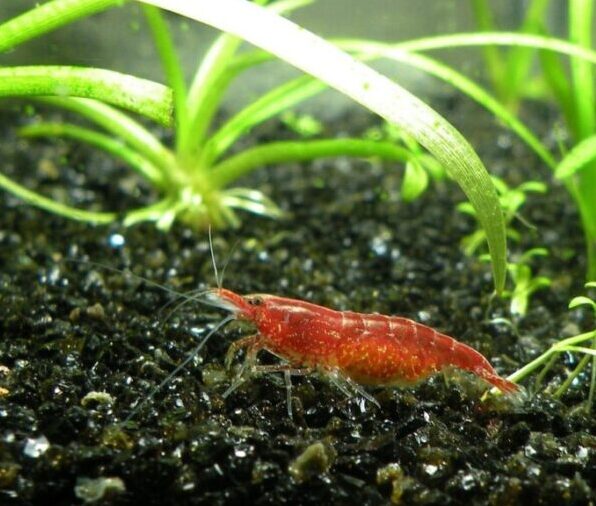Winter can be harsh for many. Luckily, specific temperature ranges and environments are sufficient enough for survival, especially when it comes to the Sakura Cherry Shrimp.
The Sakura Cherry Shrimp can survive the winter if water temperatures stay above 50 °F (10 °C). If temperatures fall below 50 °F (10 °C), shrimp can still survive but they will be inactive. Sakura Cherry Shrimp are relatively adaptable to different weather conditions.
Continue reading this article to learn more about the Sakura Cherry Shrimp and how it can survive winter conditions successfully.
What Is the Ideal Winter Condition for a Sakura Cherry Shrimp?
Many species of shrimp prefer to live in warmer climates and do not perform well in harsh winter conditions. However, certain types of shrimp like the Sakura Cherry Shrimp can perform and survive when exposed to cold temperatures.
The ideal winter condition for a Sakura Cherry Shrimp is stable water temperatures of 50 °F (10 °C) or higher. Sakura Cherry Shrimp do best in an environment of about 68 – 80 °F (20 – 26.6 °C), and they react poorly if there are drastic changes in temperature.
This is especially accurate if they are living in the wild. However, slight changes in their environment will not alter their well-being in a huge way. The Sakura Cherry Shrimp is a versatile creature that is very adaptable.
Additionally, shrimp that do live in the wild can withstand colder temperatures than those that live in a tank. Luckily, wild shrimp can also move around and adjust their environment with the seasons to find the best place for their wellbeing and health.
For shrimp that live in a tank, individuals must manage and monitor the water temperature in the tank frequently. Shrimp caretakers must make sure their Sakura Cherry Shrimp remains active and healthy at all times.
It is also valuable that owners keep the water temperature above 68 degrees for breeding. If not, shrimp will survive fine but will not be able to breed. They will become dormant.

How Cold Is Too Cold for My Sakura Cherry Shrimp?
As we now know, Sakura Cherry Shrimp are strong creatures that can thrive in a wide variety of environments. However, winter temperatures can sometimes become too cold if your shrimp is exposed to harsh conditions for too long.
Below 40 °F (4.4 °C) is too cold for your Sakura Cherry Shrimp. They can survive for a couple of weeks at 40 – 45 °F (4.4 – 7.2 °C), but they may possibly die soon after. If you have multiple shrimp in the same tank, a large percentage of them will most likely die in these temperatures.
The Sakura Cherry Shrimp is most commonly found in places like Taiwan, and they excel in tropical temperatures. With warmer water temperature and airflow, they can breed quickly, remain active, and always keep up their health throughout their short life.
Shrimp do not do well in harsh temperatures that are below 50 °F (10 °C), which is unfortunate. However, this breed of shrimp is also considered a cold water shrimp and some were found in Germany and Poland. Cold water shrimp can withstand colder temperatures without being in harm’s way immediately.
Unfortunately, many care for shrimp in multiple locations throughout the world, where temperatures vary on an extreme level. Shrimp caretakers, luckily, don’t have to worry too much about the climate or region they live in because heaters are available.
Individuals can purchase a heater for their tank, and they can heat the water, if needed, during certain seasons for their shrimp.
Here are a few great ones from Amazon.com:
- Inkbird Aquarium Heater with Probe Thermostat is a popular option to add to your shrimp’s tank. It is simple, easy to use, and perfect if you need a heater for the winter months.
- Marineland Precision Heater For Freshwater or Saltwater Aquariums is terrific. This heater can work well with tanks up to 29 gallons (131.8 liters) large and provides shrimp with precisely what they need. This option can also work with freshwater and saltwater.
- Orlushy Submersible Aquarium Heater is a popular option to consider. This option works for 10-20 gallon (45.4-90.9 liters) tanks and can hold saltwater and freshwater.
Can a Sakura Cherry Shrimp Live in an Outdoor Dwelling During the Winter?
If you’re familiar with the Sakura Cherry Shrimp, chances are you know how incredible this creature is and how to care for them. This species of shrimp can thrive under many varying conditions for more than a couple of days, regardless of whether they live in a tank or in the wild.
Sakura Cherry Shrimp can survive in an outdoor dwelling during the winter months, but they would thrive best in an indoor tank as they are located in controlled environments. In addition, individuals can monitor the water and air temperatures in an indoor dwelling during the winter.
If you plan to care for Sakura Cherry Shrimp, it is recommended to place them in an indoor tank, especially when your area has harsh winter conditions. As discussed, temperatures below 40 °F (4.4 °C) can be detrimental to your shrimp.
Having an indoor tank can help you maintain and monitor the water temperature and the room temperature daily to fit the ideal water temperature your shrimp may need.
Outdoor dwellings are not as controlled, but they can also work well. This is especially accurate if you live in a tropical region because temperatures will remain warm. Regardless of where you live, outdoor dwellings will not be an issue if owners watch over the temperatures and do their best to help their shrimp survive.
Moreover, outdoor dwellings more closely resemble the conditions in the wild where Sakura Cherry Shrimps normally thrive well.
Since we now know that different water temperatures will impact your Sakura Cherry Shrimp, you may want to know how your shrimps respond to varying temperatures:
- 68 – 82 °F (20 – 27.7 °C) helps your shrimp thrive. They can breed and are very active.
- 50 – 68 °F (10 – 20 °C) is still a positive temperature range. Your shrimp will thrive but may not be as active. Your shrimp may also stop breeding.
- 40 – 50 °F (4.4 – 10 °C) is not ideal. Your shrimp will become dormant and stop breeding. Sakura Cherry Shrimp can survive at these low temperatures, but circumstances must improve quickly. If it is at 40 degrees temperature for a couple of weeks, they may die.
Final Thoughts
All in all, Sakura Cherry Shrimp are colorful creatures that can thrive in many different environments even in winter as long as the temperature does not stay below 50 °F (10 °C) for several weeks.
If you have a shrimp that you care for, it’s best to keep up with current research. It is crucial that this type of shrimp is cared for properly at the right temperatures. This can make a huge difference in their short lifespan and breeding capacity.
Sources
- Reddit: Can cherry shrimp survive in cold water? How low can it be? Are there shrimp more suited to cold fresh water aquariums/ponds?
- Fish Keeping HQ: Keeping Shrimp in Cold Water Tank – What Works and Not
- Aquarium Gravel: Can Cherry Shrimp Survive in Cold Water?
- Care Sheet: Cherry Shrimp | Neocaridina Davidi
- University of Florida: Entomology and Nematology Department: Cherry Shrimp
Recent Posts
How Do Freshwater Shrimps Live? Freshwater shrimp are fascinating creatures that play a crucial role in aquatic ecosystems. They help maintain water quality by consuming algae and decomposing...
How Many Freshwater Shrimp Per Gallon? 4 Key Factors Freshwater shrimp are popular additions to aquariums, but many hobbyists wonder: how many shrimp can comfortably live in a gallon of water? The...

